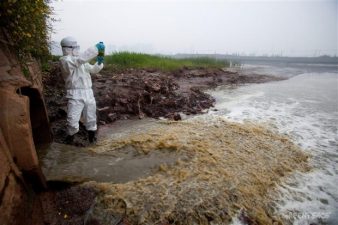Not so long ago, forests of majestic mangrove trees fringed the eastern shores of Saudi Arabia. Official stats now estimate that only 10% of the forest remains. Decades of landfill operations in support of growing urbanization destroyed the rest. Now a group of female environmental activists are battling to protect what remains.
Mangrove trees (also called shura, qurm and Ibn Sina) are evergreens that thrive in saline tidal areas along the tropical and subtropical coastlines. They range from one to five meters in height, and anchor to tidal ground with an elaborate system of exposed root structures which provide essential habitat for many marine species. including shrimp. They also provides a welcome environment for marine organisms to reproduce, particularly the Caridea. These species represent an important part of the coastal ecosystem, supplying and important feedstock for birds and fish.
Mangrove trees provide other benefits. They increase levels of oxygen and cut levels of carbon dioxide in the atmosphere, helping to reduce global warming. The trees absorb some of the chemical contaminants in their micro-environment, including oil pollution. Further, they increase green spaces, especially in the desert regions, and absorb high energy wave action and storm surge.
Women activists, spearheaded by Najwa Mohammed Bukhari, have been underpinning the cause to “save the mangroves” on the coast of al-Qatif governorate. She and the female members of Supporters of the Environment and Volunteers Association, consider mangrove protection key in the wider mission to protect Saudi’s waterfront. They’ve teamed up with the al-Ataa Charity Association for Women, working to meet their common goals.
Dalal al-Awami, head of al-Ataa’s health and environment team, told Al-Hayat,“We are making strenuous efforts to protect the environment through our communication with supporters. We got in touch with the Saif Association at Saudi Aramco and they agreed to cooperate.”
Just five women took part in the first campaign, but she stressed that “there has been an unexpected change” in the second and third campaigns. There are now over a hundred female volunteers spanning all ages and backgrounds.
“Everyone is working toward the same goal. Parents (have) encouraged their sons and daughters to join in this work with the aim of instilling in them the importance of volunteering, a concept generally absent from society, particularly in the fields of agriculture and environment,” Awami added, “By raising awareness we elevate the level of culture among people of the region. This might be done by organizing lectures, distributing leaflets and through social networking sites. This is how we manage to attract hundreds of volunteers and receive positive feedback.”
In the two years since the campaign launch, the women have made an enormous impact. Volunteers have attracted political support, which has led to a reduction in practices harmful to the forests. Their actions prompted Saudi Aramco to announced a plan to plant 1.2 million mangrove trees on the coast of the kingdom over the next four years.
In Saudi, it looks like behind every thriving mangrove, there’s a strong woman.




